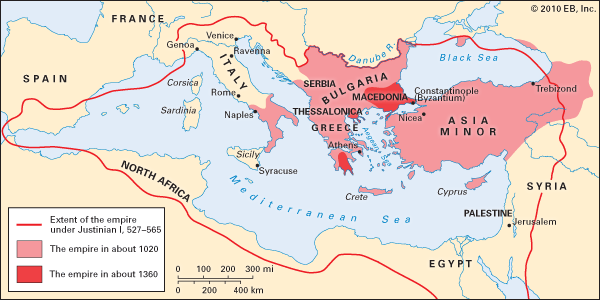Kuntz
AP Art History
AP
EUROPE - 200-1325 CE
MEDIEVAL ART Part 1: Early Christian, Byzantine, Migratory
MEDIEVAL ART Part 2: Romanesque MEDIEVAL ART Part 3: Gothic
Early Christian






In the European West, Medieval art is often broken into smaller periods. These date ranges vary by location.
c.500-800 – Early Medieval Art
c.780-900 – Carolingian Art
c.900-1000 – Ottonian Art
c.1000-1200 – Romanesque Art
c.1200-1400 – Gothic Art
(Dr. Nancy Ross)
CONTENT: What do you see?
FORM: The details (what you see more exactly). How the artist delivers the content.
CONTEXT: Everything NOT observable.
FUNCTION: The intended purpose of the work.
Assignments:
READINGS:
UNIT SHEET: below
SNAPSHOT Sheet:
APAH 250 Images:
48. Catacomb of Priscilla (Greek Chapel, Orant, Good Shepherd frescos)
49. Santa Sabina
* Old St. Peter’s
* Sarcophagus of Junius Bassus
Medieval Part 1 Unit Sheet
Vocabulary
Gospels
loculi
lunette
narthex
nave
Orant figure
spolia
transept
ambulatory
apse
atrium
basilica plan (axial plan)
catacomb
central plan
clerestory
coffer
cubical

Medieval Part 1 Unit Sheet


Byzantine









READINGS:
UNIT SHEET: below
SNAPSHOT Sheet:
Assignments:

cathedral
chalice
codex
continuous narrative
Eucharist
Genesis
Icon
Iconostasis
mosaic
paten
pendentive
squinch
Theotokos
Vocabulary
APAH 250 Images:
52. Hagia Sophia
51. San Vitale (including Justinian and Theodora panels)
54. Virgin (Theotokos) and Child between Saints Theodore and George
50. Vienna Genesis (Rebecca and Eliezer at the Well and Jacob)
Migratory


St Matthew, cross-carpet page

St. Luke portrait page

St. Luke incipit page
Assignments:
READINGS:
UNIT SHEET: below
SNAPSHOT Sheet:
APAH 250 Images:
53. Merovingian looped fibulae
55. Lindisfarne Gospels, St. Matthew, cross-carpet page; St. Luke incipit page
cloisonne
codex
fibula
gospels
horror vacui
parchment (vellum)
scriptorium
zoomorphic
Vocabulary
MEDIEVAL ART Part 2: Romanesque
Romanesque






Assignments:
READINGS:
UNIT SHEET: below
SNAPSHOT Sheet:
Romanesque Unit Sheet
APAH 250 Images:
APAH 250 Images:
58. Church of Sainte-Foy
- Reliquary of Sainte-Foy
- Tympanum of Sainte-Foy (the Last Judgment)
59. Bayeux Tapestry

Vocabulary
portal
reliquary
rib vault
tapestry
transept
transverse arch
triformium
trumeau
tympanum
voussoir
campanile
embroidery
jamb
Last Judgment
ambulatory
apse
arcade
archivolt
bay

Romanesque Unit Sheet
10 Characteristics of the Romanesque style (Matt Curess)
-
First international style since the Roman Empire (Germany, Normandy, England, Tuscany)
-
Competition for the largest church (Pisa Cathedral)
-
Mansonry (no concrete)
-
East end of church is the religious focal point for services
-
Portals act as a "billboard" for elements of faith (The Last Judgement)
-
Cruciform plans, church as a metaphor for heaven
-
Plans/elevation based on basilican forms
-
Bays divide the nave into compartments
-
Rounded arches are the norm
-
Tripartite division of the elevation continues from earlier periods
MEDIEVAL ART Part 3: Gothic
Gothic









Assignments:
READINGS:
UNIT SHEET: below
SNAPSHOT Sheet:
Gothic Unit Sheet
APAH 250 Images:
60. Chartres Cathedral
- West, North, South Portals
- Notre Dame de la Bella Verriere
* Rheim Cathedral – Visitation/jamb statues
* Strasbourg Cathedral – Death of the Virgin
tympanum
* Naumburg Cathedral – Ekkehard and Uta
61. Dedication Page with Blanche of Castile and
King Louis IX of France
62. Röttgen Pietà
* Visitation, jamb statues, Reim Cathedral
* The Virgin of Paris
* The Virgin of Jeanne d’Evreaux reliquary
Need to Know Vocabulary:
gargoyles
lux nova
pinnacle
crocket
oculus
vault webbing
fan vaulting
quatrefoil/trefoils
Cult of the Virgin
portal
Rayonnant style
Flamboyant style
Perpendicular style
pointed arch
ambulatory
ribbed groin vault
flying buttress
nave arcade
triforium
tribunal gallery
aisle
nave
ambulatory
clerestory
choir
stringcourse

Gothic Unit Sheet
Key Ideas:
-
"Gothic" term coined by the historian Georgia Vasari during the Renaissance. Originially meant to be derogative as he thought the gothic style was crude and ugly.
-
Perfected the Romanesque style (ribbed vaults, groin vaults, pointed arches, and clerestories.
-
The quest for Height and Light is very important. The higher the architecture, the closer to God you'll be. Light is the manifestation of God known as lux nova, new light.
-
Sculpture/reliefs are higher in relief and emphasizes the verticality of the architecture.
-
Women were no longer considered "handmaidens of the devil". The Cult of the Virgin replaced a previous veneration of Eve, the great sinner.
-
Saint Denis is the first fully Gothic structure in France. The ambulatory becomes the new focus. Abbot Suger is credited to creating this new gothic style. He believed the church should be of great beauty. The more grand, the closer to God the worshipper could become.